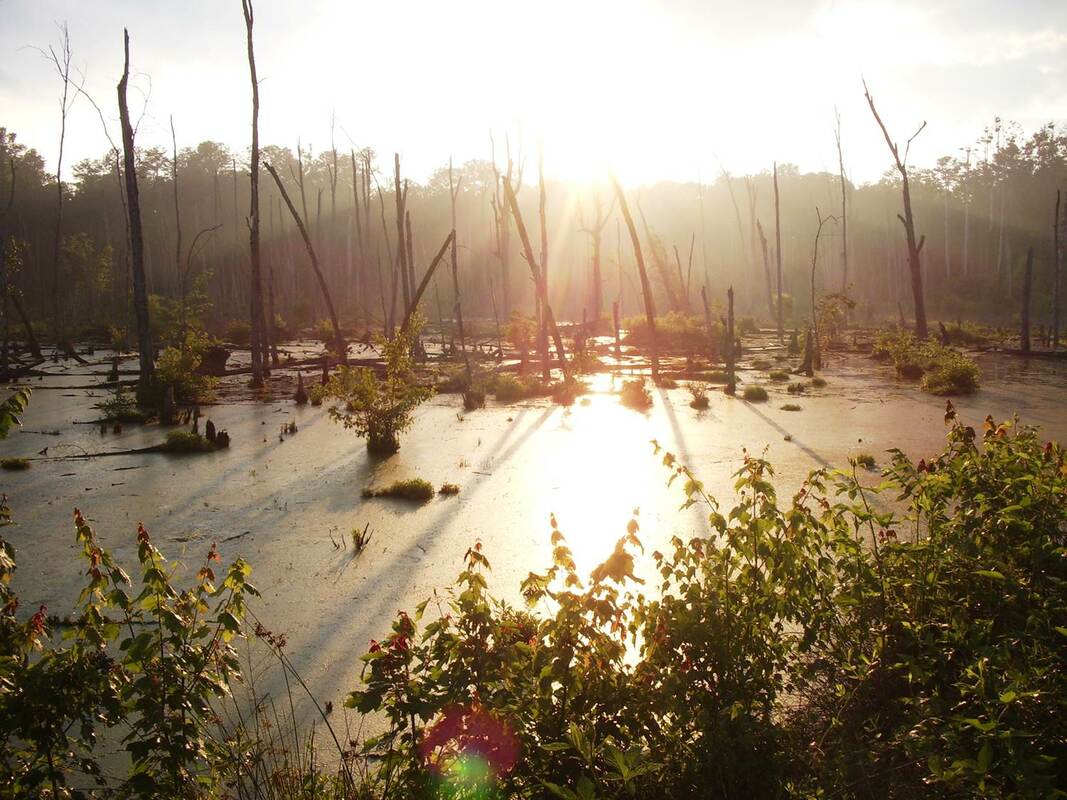|
Map showing Allabay's Creek (Ellerbe Creek). You can see the two tributaries of South Ellerbe--one flowing through present-day Old West Durham and Walltown, and the other flowing north past what is now Durham Central Park, Trinity Park, Old North Durham, and Duke Park.
Houses line drainage ditch in Durham (1940).
|
The 37 square miles of land that drain into Ellerbe Creek are known as its watershed. Most of this land is in the heart of Durham, North Carolina.
On early maps, Ellerbe Creek was spelled "Allibay,” a name that some theorized was Native American. After all, the North Carolina Piedmont was once dominated by Sioux-speakers such as the Eno, Occaneechi, Saponi, Sissipahaw, Tutelo, and Shoccoree. However, historian Jean Anderson opines that the Creek is named for the John Ellerby (Allaby) family who, according to The Colonial Records of North Carolina (1886-90), lived on land in what is present-day Durham. Whatever the origin, the creek has carried many names over the years, including Allibay, Allibay’s, Eleby, Ellerbee, Ellerbie, and our (and the state’s!) prefered spelling: Ellerbe. One of Ellerbe Creek’s earliest mentions comes from Bennett Place, site of the Civil War’s largest troop surrender, which is crossed by Ellerbe feeders. James Bennitt's original deed mentions that his land was on "waters of New Hope Creek and Ellerbe Creek," meaning it was on both sides of the ridge that divides the Neuse and Cape Fear watersheds. Today, the North Carolina Railroad crosses Durham following this ridge. To the north of the tracks, all tributaries, including Ellerbe creek and its feeders, flow past Raleigh, Smithfield, Goldsboro, Kinston, and New Bern into Pamlico Sound. South of the tracks, the tributaries empty into New Hope Creek—eventually flowing into the Atlantic below Southport. Sadly, pollution is a part of any urban watershed’s history, and Ellerbe is no different in this respect. During the days of the Erwin Cotton Mills, South Ellerbe Creek was channelized and used to dump warm dyes from the mills. In the early days, the entire neighborhood smelled like a laundromat from the hot, soapy water being discharged by the textile mills into South Ellerbe. At the dawn of the new millennium, many of the mill families still in Old West Durham simply called it the "ditch." In more recent years, near the city dump, Ellerbe Creek was channelized, choked with industrial effluent and leachate (which one writer has called "garbage juice"). Along some wooded stretches, Ellerbe's creeks quietly flow through areas as scenic as any in North Carolina. Elsewhere, the Ellerbe has earned a reputation as one of the state's most polluted creeks. Flowing past history and through Durham's neighborhoods, these rivulets, though beloved by many, absorb the city's ills. The goal of the Ellerbe Creek Watershed Association, founded in 1999, is to help citizens live in harmony with this creek, a collaboration that results in clean drinking water and stronger, healthier neighborhoods. This history was adapted from a historical narrative of Ellerbe Creek by John Schelp. Photos are courtesy of the Old West Durham Neighborhood Association. |
How You Can Help
|
|
|
|






